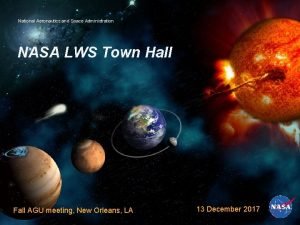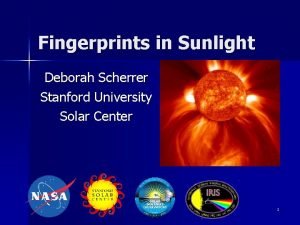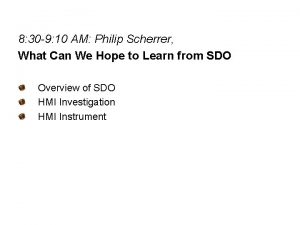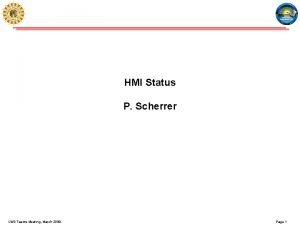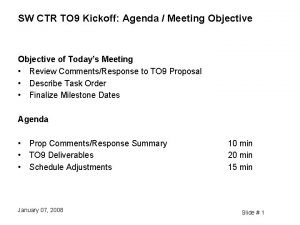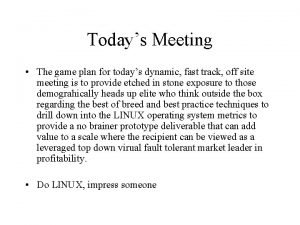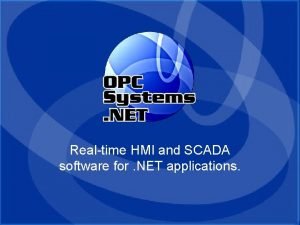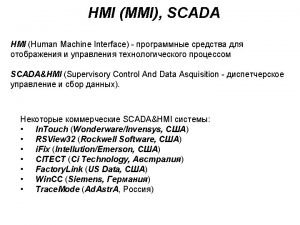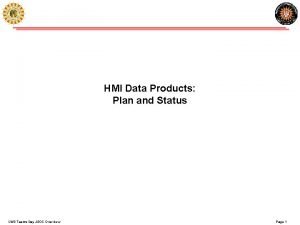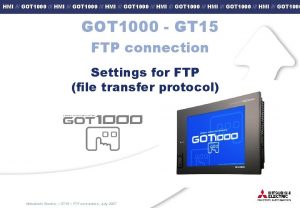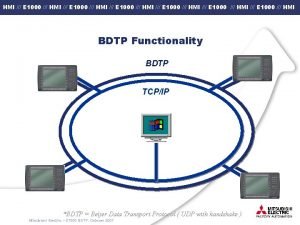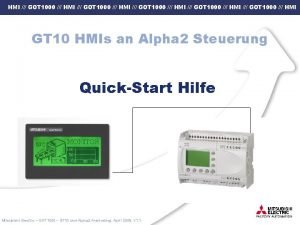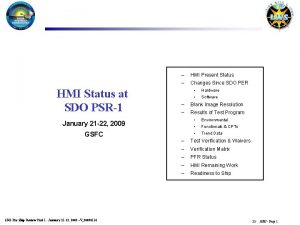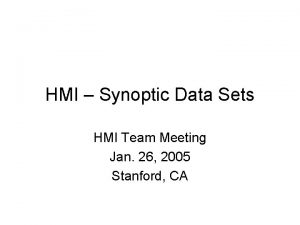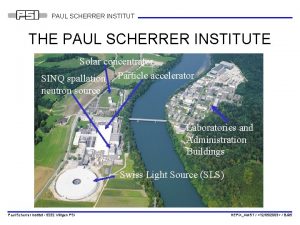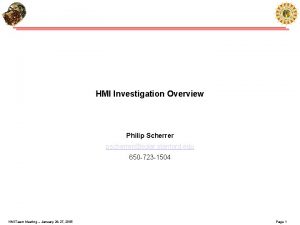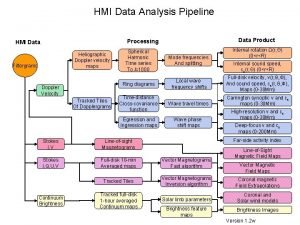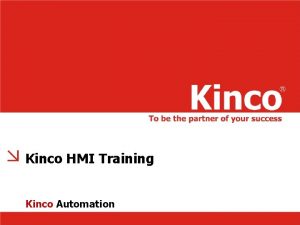HMI Status P Scherrer LWS Teams Meeting March















- Slides: 15

HMI Status P. Scherrer LWS Teams Meeting, March 2008 Page 1

HMI Primary goal Origin of Solar Variability • The primary goal of the Helioseismic and Magnetic Imager (HMI) investigation is to study the origin of solar variability and to characterize and understand the Sun’s interior and the various components of magnetic activity. • HMI produces data to determine the interior sources and mechanisms of solar variability and how the physical processes inside the Sun are related to surface and coronal magnetic fields and activity. LWS Teams Meeting, March 2008 Page 2

HMI Instrument on SDO AIA • HMI Instrument – HMI Optics Package (HOP) EVE X – HMI Electronics Box (HEB) Y – Intra Instrument Harness Z – Flight Software HMI HOP LWS Teams Meeting, March 2008 HEB Page 3

All moved in! HOP HEB Harness LWS Teams Meeting, March 2008 Page 4

HMI is Ready • The HMI instrument was delivered to NASA last November • HMI is integrated onto SDO • HMI will meet “Level-1” observing requirements • It is a fine instrument, we are very pleased with it • There a few minor issues that must and will be resolved in the coming month or two, e. g. : – A few flight software issues expected to be resolved by May – Front window birefringence change with temperature to be explored with spare • There a few minor issues that will be resolved after launch, e. g: – Temperature control method and variations during orbit – Tuning parameters for data compression - variations with tuning and polarization • There a few items to be determined after launch, e. g. : – “Best” framelist for observing sequence – Can we combine data from both cameras to compute “Observables” – The internal structure and dynamics of the Sun and the sources of solar variability LWS Teams Meeting, March 2008 Page 5

So, the first 6 years work of many got the instrument done but we are not yet ready for data to flow or to accomplish the science. . LWS Teams Meeting, March 2008 Page 6

Primary Science Objectives 1. 2. 3. 4. 5. Convection-zone dynamics and solar dynamo – Structure and dynamics of the tachocline – Variations in differential rotation. – Evolution of meridional circulation. – Dynamics in the near-surface shear layer. Origin and evolution of sunspots, active regions and complexes of activity – Formation and deep structure of magnetic complexes. – Active region source and evolution. – Magnetic flux concentration in sunspots. – Sources and mechanisms of solar irradiance variations. Sources and drivers of solar activity and disturbances – Origin and dynamics of magnetic sheared structures and delta-type sunspots. – Magnetic configuration and mechanisms of solar flares and CME. – Emergence of magnetic flux and solar transient events. – Evolution of small-scale structures and magnetic carpet. Links between the internal processes and dynamics of the corona and heliosphere – Complexity and energetics of solar corona. – Large-scale coronal field estimates. – Coronal magnetic structure and solar wind Precursors of solar disturbances for space-weather forecasts – Far-side imaging and activity index. – Predicting emergence of active regions by helioseismic imaging. – Determination of magnetic cloud Bs events. LWS Teams Meeting, March 2008 Page 7

HMI Science Analysis Plan HMI Data Processing Data Product Science Objective Tachocline Global Helioseismology Processing Internal rotation Ω(r, Θ) (0<r<R) Internal sound speed, cs(r, Θ) (0<r<R) Differential Rotation Local Helioseismology Processing Full-disk velocity, v(r, Θ, Φ), And sound speed, cs(r, Θ, Φ), Maps (0 -30 Mm) Activity Complexes Filtergrams Carrington synoptic v and cs maps (0 -30 Mm) Observables Doppler Velocity High-resolution v and cs maps (0 -30 Mm) Deep-focus v and cs maps (0 -200 Mm) Far-side activity index Line-of-sight Magnetograms Vector Magnetograms Continuum Brightness Line-of-Sight Magnetic Field Maps Near-Surface Shear Layer Active Regions Sunspots Irradiance Variations Magnetic Shear Flare Magnetic Configuration Flux Emergence Magnetic Carpet Coronal energetics Vector Magnetic Field Maps Large-scale Coronal Fields Coronal magnetic Field Extrapolations Far-side Activity Evolution Coronal and Solar wind models Brightness Images LWS Teams Meeting, March 2008 Meridional Circulation Solar Wind Predicting A-R Emergence IMF Bs Events Version 1. 0 w Page 8

HMI Standard Product Pipeline Processing HMI Data Heliographic Doppler velocity maps Filtergrams Level-0 Doppler Velocity Spherical Harmonic Time series To l=1000 Mode frequencies And splitting Ring diagrams Local wave frequency shifts Time-distance Tracked Tiles Cross-covariance Of Dopplergrams function Egression and Ingression maps Level-1 Data Product Wave travel times Wave phase shift maps Internal rotation Ω(r, Θ) (0<r<R) Internal sound speed, cs(r, Θ) (0<r<R) Full-disk velocity, v(r, Θ, Φ), And sound speed, cs(r, Θ, Φ), Maps (0 -30 Mm) Carrington synoptic v and cs maps (0 -30 Mm) High-resolution v and cs maps (0 -30 Mm) Deep-focus v and cs maps (0 -200 Mm) Far-side activity index Stokes I, V Line-of-sight Magnetograms Stokes I, Q, U, V Full-disk 10 -min Averaged maps Vector Magnetograms Fast algorithm Tracked Tiles Vector Magnetograms Inversion algorithm Coronal magnetic Field Extrapolations Tracked full-disk 1 -hour averaged Continuum maps Solar limb parameters Coronal and Solar wind models Brightness feature maps Brightness Images Continuum Brightness HMI Data Analysis Pipeline LWS Teams Meeting, March 2008 Line-of-Sight Magnetic Field Maps Vector Magnetic Field Maps Page 9

Status of HMI Science Processing Plan Development • • • Data analysis pipeline: standard helioseismology and magnetic field analyses will produce “Standard” data products “Level-1” Observable program development just now getting started. None of the “pipelines” are functioning yet. Most pipeline elements need updated software. Targeted numerical modeling is proceeding. Focused data analysis and science working groups continue to be important. Joint investigations with AIA and EVE need development. Cooperation with other space- and ground-based projects (SOHO, Hinode, PICARD, STEREO, RHESSI, GONG+, SOLIS, HELAS) needs development. After this meeting we will evaluate which pipeline elements must proceed with existing algorithms and code and which will get improvements. It is clear that “standard products” will evolve early in the mission. LWS Teams Meeting, March 2008 Page 10

Summary • The HMI Instrument is ready to provide key data to study the Sun’s dynamics and magnetism: subsurface flow maps and photospheric vector magnetic fields. • There are some minor issues, some will be fixed and some we will live with. • It needs to be in the sky. • The HMI data analysis plan includes a standard pipeline processing and on demand data analysis tools. • The analysis pipeline is being developed by the Co-I team, using existing techniques and software. • Since many Co-Is do not have funding to prepare, some of the planned data products may not be available at the start of the mission. • Many “Traditional” data product pipelines will be ready if the present rate of development continues. • Work on the “white boxes” will likely wait until after launch. LWS Teams Meeting, March 2008 Page 11

DONE More Details on HMI status follow LWS Teams Meeting, March 2008 Page 12

HMI status • Completed mechanical integration with the SDO spacecraft – Optics package alignment is within the requirement – MLI closeout was completed (except for a couple access points) • Completed electrical integration – Discovered low LVDS isolation resistance which indicated ESD damage to LVDS – Completed LVDS rework (see “Changes Since PSR” chart) • HMI completed the stand alone CPT and the observatory CPT#1 • HMI hardware is in flight configuration with the following exceptions – Flight software update is planned prior to CPT#2 – Need to stake the MLI around the front door – Closeout MLI around alignment cube – Remove red tag items LWS Teams Meeting, March 2008 Page 13

Flight Software Status • Delivered FSW with known issues and planned software update at observatory – Developed a list of software updates with SDO Project based on existing software problem reports and targeted improvements • Incorporate known discrepancies (DAI) • Incorporate IV&V findings • Complete high speed bus (HSB) resynchronization development • Developed software test bed for software testing • Completed most non-HSB related software changes and testing in work – Closed 23 of 26 DAIs and all IV&V findings • Demonstrated most HSB functionality and code is being debugged – Remaining software verification items will be closed upon completion of the next SWAT – Test bed will be used for in-house test prior to delivery – SWAT will be performed upon code update at the observatory level • Software update does not effect EMI/EMC operating modes and analysis • Software update is planned for May 15 th at the observatory prior to CPT#2 and thermal vacuum test LWS Teams Meeting, March 2008 Page 14

HMI Observables Performance Issues In no particular order: • Some scattered light in column direction, small but not well quantified. • MTF measurements still include Stim-Tel, data in hand, needs analysis. • Front window birefringence temp sensitivity, may reduce mag sensitivity • CCD gain stability not well measured. • CCD full well less than expected, but meets min requirements. • Uncertainty best focus setting, but small part of range. • Gravity release change in distortion, field flatness, etc. , never tested but some variations when rotated 90 degrees, but small. • Strange up-down motion in Lyot tuning motor/waveplate, requires registration • HSB robustness, possibly fixed – not tested. • Sequencer has some unexplained failures, but rare • Almost no solar data during testing, but some • Flat field not demonstrated at needed level, but close • Antenna induced jitter avoidance not tested, but small. LWS Teams Meeting, March 2008 Page 15
